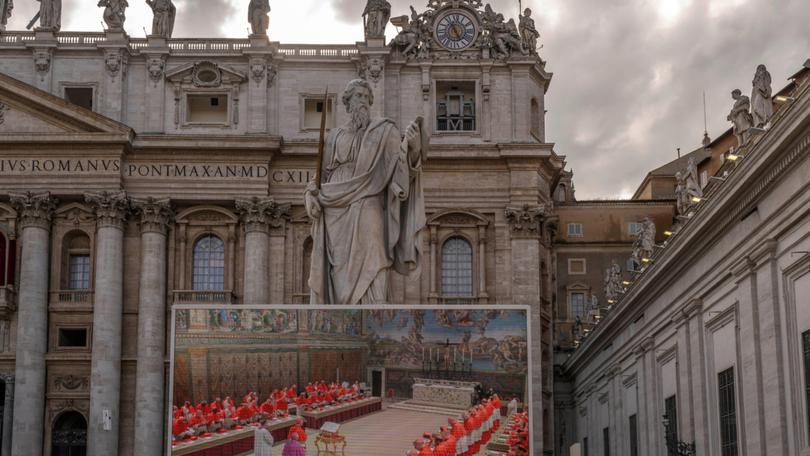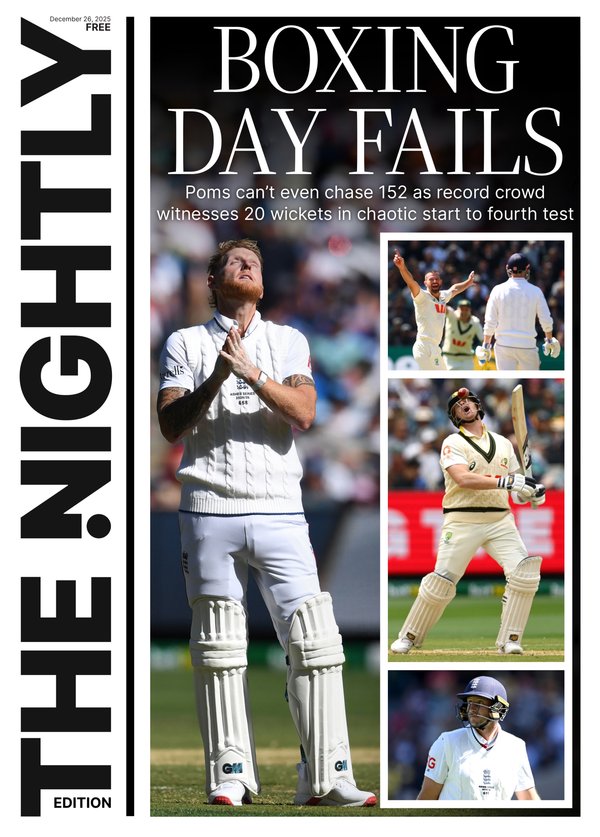Black smoke pours from Sistine Chapel chimney, indicating no pope was elected as conclave opens

Cardinals have returned to the Sistine Chapel on Thursday to resume voting for a new pope after the first conclave ballot failed to find a winner, sending billowing black smoke through the chapel chimney.
Some of the 133 voting cardinals from 70 countries — including Australia’s Ukraine-born Mykola Bychok — had said they expected a short conclave to replace Pope Francis. But it will likely take a few rounds of voting for one man to secure the two-thirds majority, or 89 ballots, necessary to become the 267th pope.
For much of the past century, the conclave has needed between three and 14 ballots to find a pope. John Paul I — the pope who reigned for 33 days in 1978 — was elected on the fourth ballot. His successor, John Paul II, needed eight. Francis was elected on the fifth in 2013.
Sign up to The Nightly's newsletters.
Get the first look at the digital newspaper, curated daily stories and breaking headlines delivered to your inbox.
By continuing you agree to our Terms and Privacy Policy.The cardinals opened the secretive, centuries-old ritual Wednesday afternoon, participating in a rite more theatrical than even Hollywood could create.
That’s despite reports from Politico that a number of cardinals involved in the current vote admitted to watching Edward Berger’s Oscar-nominated 2024 film Conclave in a bid to familiarise themselves with the process.
One cardinal confirmed to the US news site that several colleagues had viewed the movie at the cinemas, with some seeing it as a useful tool given the relative inexperience of certain conclave members when it came to Vatican “politics and protocol”.
Put into practice on Wednesday, that protocol has seen Cardinal Pietro Parolin, the 70-year-old secretary of state under Francis and a leading contender to succeed him as pope, assuming leadership of the proceedings as the senior cardinal under age 80 eligible to participate.
Cardinal Parolin stood before Michelangelo’s vision of heaven and hell, The Last Judgment, and led the other cardinals in a lengthy oath. Each one followed, placing his hand on the Gospel and promising in Latin to maintain utmost secrecy. The ritual a wash of red-robed cardinals, Latin chants, incense and solemnity that underscored the magnitude of the moment.
Outside in St. Peter’s Square, the scene was festive as thousands of people flocked to the piazza to watch the proceedings on giant video screens, applauding when the Sistine Chapel’s doors slammed shut and the voting began.
They waited for hours, watching screens that showed just a skinny chimney and occasional seagull. After the vote dragged on to dinnertime, some left in frustration, but those who stayed cheered when the smoke finally billowed out.
“My hope is that cardinals will choose a man who can be a peacemaker and could reunify the church,” said Gabriel Capry, a 27-year-old from London.
A diverse group of cardinals
Hailing from 70 countries, the cardinals were sequestered Wednesday from the outside world, their cellphones surrendered and airwaves around the Vatican jammed to prevent all communications until they find a new pope.
Francis named 108 of the 133 “princes of the church,” choosing many pastors in his image from far-flung countries like Mongolia, Sweden and Tonga that had never had a cardinal before.
His decision to surpass the usual limit of 120 cardinal electors and include younger ones from the “global south” — often marginalized countries with lower economic clout — has injected an unusual degree of uncertainty in a process that is always full of mystery and suspense.
Many cardinals hadn’t met until last week and lamented they needed more time to get to know one another, raising questions about how long it might take for one man to secure the two-thirds majority, or 89 ballots, necessary to become the 267th pope.
“Wait and see, a little patience, wait and see,” said Cardinal Mario Zenari, the Vatican’s ambassador to Syria.
The oath and “Extra omnes”
The cardinals had entered the Sistine Chapel in pairs, chanting the meditative “Litany of the Saints” as Swiss Guards stood at attention. The hymn implores the saints to help the cardinals find a leader of the 1.4 billion-strong church.
Cardinal Pietro Parolin, the 70-year-old secretary of state under Francis and himself a leading contender to succeed him as pope, assumed the leadership of the proceedings as the senior cardinal under age 80 eligible to participate.
He stood before Michelangelo’s vision of heaven and hell, “The Last Judgment,” and led the other cardinals in a lengthy oath. Each one followed, placing his hand on the Gospel and promising in Latin to maintain utmost secrecy.
Earlier in the day, the dean of the College of Cardinals, Cardinal Giovanni Battista Re, presided over a morning Mass in St. Peter’s Basilica urging the voters to set aside all personal interests and find a pope who prizes unity. He prayed for a pope who could awaken the conscience of the world.
He reminded the cardinals that the awesomeness of the Sistine Chapel’s frescoes is meant to remind the cardinals of the weighty responsibility they bear. In his regulations for the conclave, Re recalled, St. John Paul II wrote that in the Sistine Chapel, “everything is conducive to an awareness of the presence of God.”
After the cardinals took their oaths, the master of papal liturgical ceremonies, Archbishop Diego Ravelli, called out “extra omnes,” Latin for “all out” and anyone not eligible to vote left before the chapel doors closed. An elderly cardinal remained to deliver a meditation, but after he finished, he too, had to leave since he was too old to vote.
While cardinals this week said they expected a short conclave, it will likely take at least a few rounds of voting. For much of the past century, it has taken between three and 14 ballots to find a pope. John Paul I — the pope who reigned for 33 days in 1978 — was elected on the fourth ballot. His successor, John Paul II, needed eight. Francis was elected on the fifth in 2013.
Lobbying before the conclave
The cardinals are supposed to resist any “secular” influences in their choice of pope, but such lobbying abounded in Rome in the days before the conclave as various groups reminded cardinals of what ordinary Catholics want in a leader.
Young Catholics penned an open letter reminding cardinals that there is no church without young people, women and the laity. Conservative Catholic media slipped cardinals copies of a glossy book containing their assessments of contenders. Survivors of clergy sexual abuse warned cardinals that they would be held accountable if they failed to find a leader who will crack down on decades of abuse and cover-up.
Advocates for women’s ordination sent pink smoke signals Wednesday over the Vatican to demand that women be allowed to be priests and participate in a conclave.
Even the White House got involved, posting a photo of President Donald Trump dressed as a pope. Trump said it was a joke, but the gesture was denounced by former Italian Premier Romano Prodi as “indecent” political interference in matters of faith that hark back to times when secular rulers intervened in conclaves.

Cardinal Timothy Dolan, the archbishop of New York, said there was also plenty of lobbying going on among cardinals themselves.
“You invite each other out,” Dolan said on SiriusXM’s The Catholic Channel before the conclave began. “And you’re pretty blunt. Now, we’re not, you know, we’re not horse trading here. We’re saying, ‘Tell me about this guy. You’re from Latin America. Go through the list of bishops. Tell me some of these fellas. Am I right to be enchanted by this guy?’”
Lisette Herrera, a 54-year-old tourist from the Dominican Republic, was deeply moved to find herself by chance in Rome as the conclave began. She decided Wednesday morning to skip the Spanish Steps and Trevi Fountain and pray instead in St. Peter’s Square.
“I’m praying to the Holy Spirit for a young pope who would stay with us for a long time,” she said. “I don’t believe in conclave politics, I just feel that the Holy Spirit is here and that’s all we need to know.”
Challenges facing a new pope
Many challenges await the new pope and weigh on the cardinals — above all whether to continue and consolidate Francis’ progressive legacy on promoting women, LGBTQ+ acceptance, the environment and migrants, or roll it back to try to unify a church that became more polarized during his pontificate. The clergy sex abuse scandal hung over the pre-conclave talks.
Since Francis chose 80% of the voters, continuity is likely, but the form it might take is uncertain and identifying front-runners has been a challenge.
But some names keep appearing on lists of “papabile,” or cardinals having the qualities to be pope. In addition to Parolin, they include:
— Filipino Cardinal Luis Tagle, 67, a top candidate to be history’s first Asian pope. He headed the Vatican’s evangelization office responsible for the Catholic Church in much of the developing world.
— Hungarian Cardinal Peter Erdo, 72, the archbishop of Budapest, is a leading candidate representing the more conservative wing of the church.
